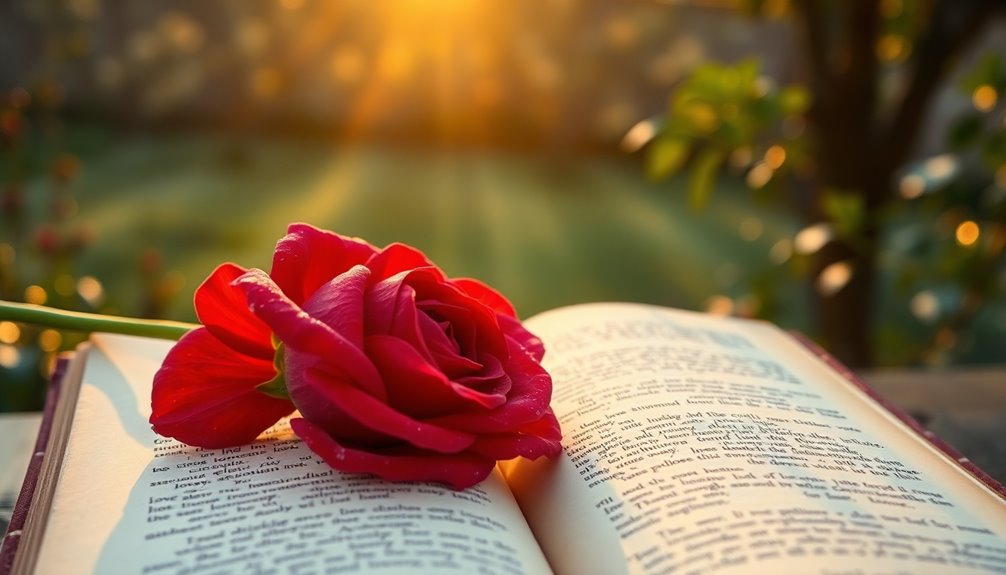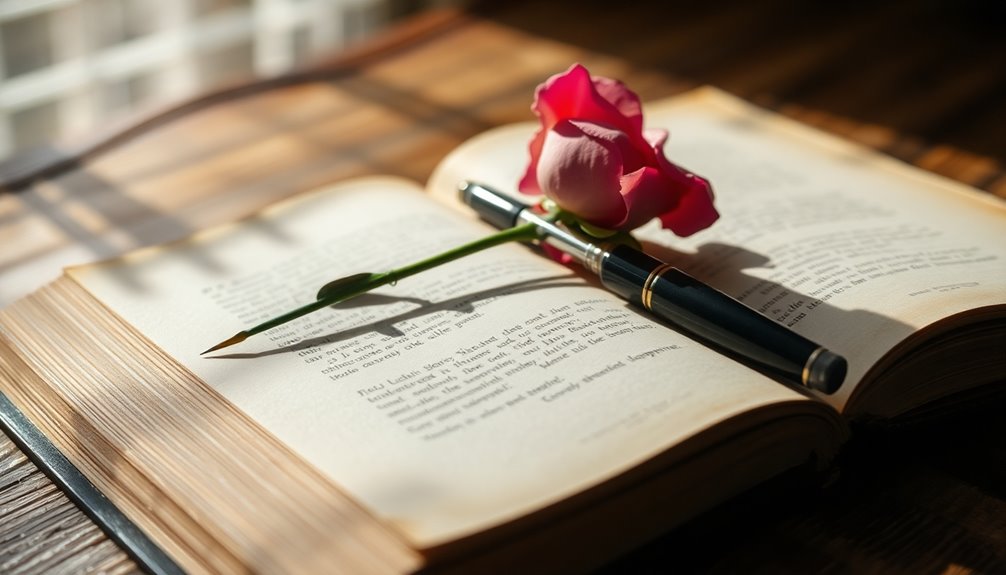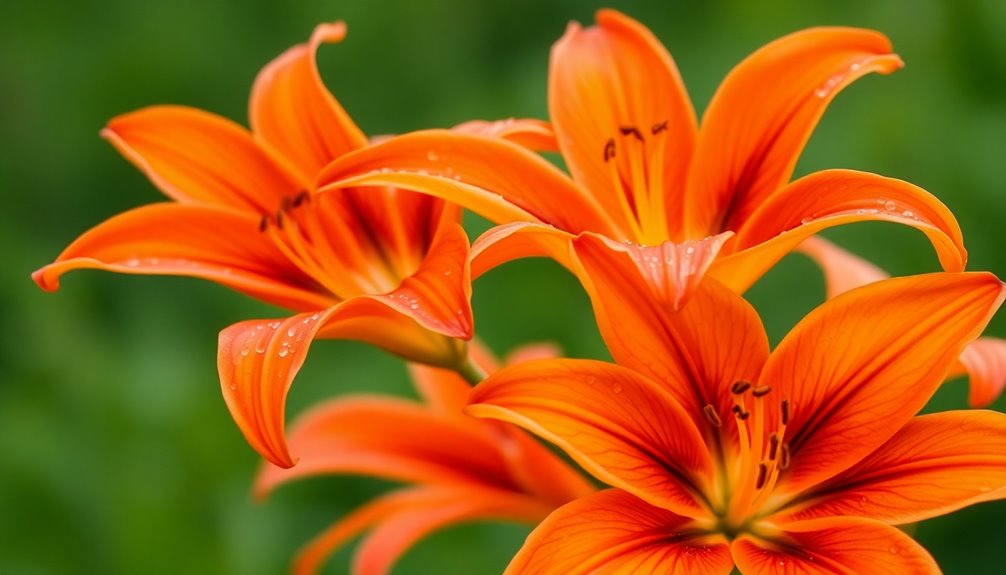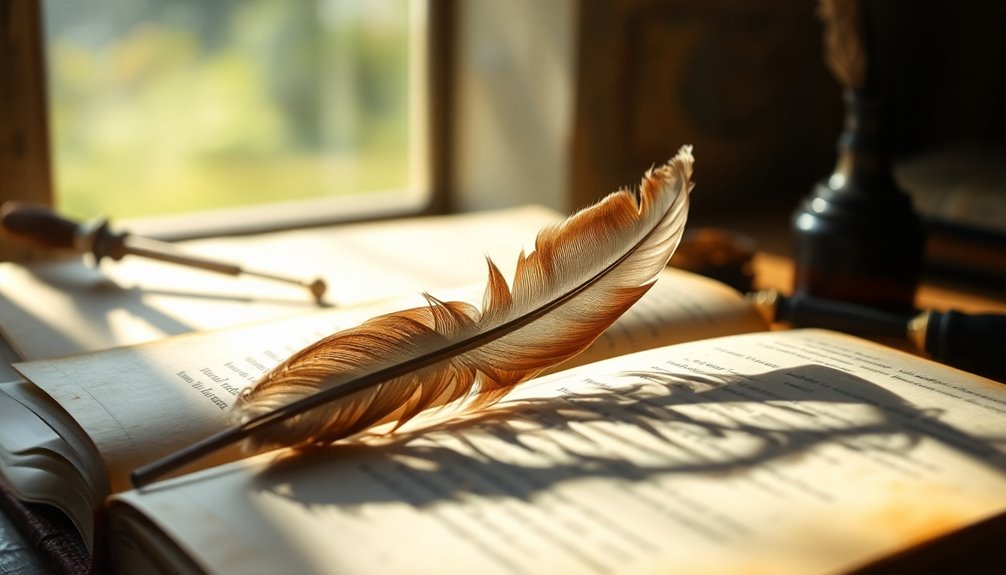Symbolism in poetry is a fun and creative way to express big ideas and feelings using simple images. For example, a red rose often stands for love, while the sun might symbolize hope. Famous poets like Wordsworth use daffodils to show happiness, and Dickinson uses light to represent hope. Nature also plays a big role; a river can symbolize life's journey, and seasons can reflect different life stages. These symbols create deeper meanings and help you connect emotionally with the poem. You'll discover many more exciting examples as you explore the magical world of symbolism!
Key Takeaways
- Symbolism in poetry conveys complex ideas through simple images, enhancing emotional engagement and relatability for readers.
- Common symbols include red roses for love, the sun for hope, and nature symbols representing life cycles.
- Notable examples include Wordsworth's daffodils for happiness, Dickinson's light for hope, and Blake's chimney sweepers highlighting social injustice.
- Nature symbolizes life's phases, with seasons representing rebirth and dormancy, while rivers and mountains symbolize journeys and obstacles.
- Analyzing symbols involves considering repetition, emotional tone, and cultural context to uncover deeper meanings and social commentary.
Understanding Symbolism in Poetry

Symbolism in poetry is a powerful tool that poets use to convey complex ideas and emotions through simple images or actions. When you read a poem, look for symbols—objects, actions, or images that represent larger ideas. For example, a red rose often symbolizes love and passion, but its meaning can change based on the context.
Nature is another common source of symbolism in poetry. The sun might represent life and hope, while seasons can symbolize cycles of change and renewal. As you explore these symbols, you'll notice how they can provoke strong emotional responses. This makes the poem feel more personal and relatable.
To truly understand symbolism in poetry, you need to reflect on the context. Cultural and historical factors can greatly influence what a symbol means. Ask yourself, "What do these symbols say about the poem's message?"
Importance of Symbolism

Many readers mightn't realize just how essential symbolism is in poetry. When poets use symbolism, they help create deeper meanings in their work. Objects, actions, or ideas can stand for larger concepts or emotions. This makes your reading experience much richer and more exciting!
Symbolism also sparks your imagination and emotions. As you read, you might picture strong images or feel powerful feelings, drawing you into the poem. Plus, it encourages you to think critically. You'll need to reflect on the context and cultural significance of the symbols to truly grasp their meaning.
Additionally, symbolism allows poets to comment on societal issues or share personal experiences without directly stating them. This indirect approach can make their messages even more powerful.
Notable Symbolism Examples

Poets craft vivid imagery through symbolism, allowing you to explore deeper meanings embedded in their work.
Take William Wordsworth's "I Wandered Lonely as a Cloud," where daffodils symbolize freedom, peace, and happiness. You can feel the joy of nature as you read.
Emily Dickinson often uses light as a symbol, representing hope and happiness, especially in her poems about spring and renewal. It's like a warm hug for your spirit!
On the other hand, Percy Bysshe Shelley uses the moon as a symbol of loneliness and unrequited love, tapping into your emotions.
A.E. Housman's "A Shropshire Lad" features a ferry as a symbol of death and life's fleeting nature, reminding you that time is precious.
In William Blake's "London," chimney sweepers symbolize child labor and neglect, while palace walls represent the oppressive monarchy. This highlights social injustices that still matter today.
Each of these symbols invites you to think more deeply about love, loss, and the world around you.
Nature as a Symbol

Nature often serves as a profound mirror for human emotions, capturing the essence of our experiences in striking ways. Through symbolism, poets express feelings and ideas that resonate deeply within us.
For instance, think of how the seasons reflect our lives:
- Spring symbolizes rebirth and new beginnings.
- Winter embodies quiet dormancy, reminding us of life's pauses.
- Rivers can represent journeys or struggles we face.
- Mountains symbolize obstacles, encouraging perseverance.
William Blake's sunflower shows humanity's weariness and life's journey. Matsuo Basho uses the passing spring to highlight life's fleeting beauty. Robert Burns' red rose stands as a powerful symbol of love and romance, connecting nature to our emotions.
These natural elements keep us grounded, helping us understand our feelings through the beauty around us.
When you read poetry, pay attention to how nature enhances the themes. You'll discover that every leaf, flower, and season holds a special meaning. By embracing this symbolism, you can connect more deeply with the poems you encounter.
Nature's beauty not only enriches our world but also our understanding of ourselves.
Emotional Resonance in Symbols

Symbols in poetry can really spark your feelings and connect you to the big ideas the poet wants to share.
When you see a red rose, it might remind you of love, while a passing spring could make you think about how life changes so quickly.
These symbols help you explore your own emotions and thoughts, making each poem a unique adventure for you!
Impact on Reader's Feelings
Evoking emotions through symbols allows readers to forge a profound connection with poetry, transforming simple imagery into powerful representations of complex feelings. When you come across a symbol in a poem, it can spark a whirlwind of emotions inside you. These symbols often stand for deeper meanings, making you feel things that words alone can't express.
- A red rose can ignite feelings of love and passion.
- A passing spring may remind you of life's fleeting moments.
- A dark storm could represent fear or uncertainty.
- A bright sun might evoke joy and hope.
These symbols draw you in and make you think. They can help you relate to experiences like love, loss, or even happiness.
As you read, you might find yourself reflecting on your own feelings, making the poem personal and meaningful. This connection is what makes poetry so special. By using symbols, poets give you a window into their world, inviting you to explore your own emotions.
Connection to Themes
The emotional resonance found in symbols allows you to connect deeply with a poem's themes, enriching your reading experience. When you encounter a symbol, it evokes feelings that match its meaning, making the poem's message stronger and clearer.
For instance, in Robert Burns' work, the red rose symbolizes love and romance. This symbol resonates with your emotions, enhancing themes of affection and beauty.
Natural elements also serve as powerful symbols. Take William Blake's sunflower, which represents humanity's weariness. This relates personal feelings to broader themes, helping you understand the human experience.
Similarly, in Emily Dickinson's poetry, light symbolizes hope and happiness, especially during spring. This creates a joyful link between renewal and joy.
Symbols can also have layers of meaning, allowing for multiple interpretations. For example, Percy Bysshe Shelley's moon represents loneliness and unrequited love. This complexity engages you with rich emotional themes, inviting you to explore the poem further.
Symbolism in Social Commentary

Symbolism in social commentary is like a secret code poets use to talk about important issues.
For example, when you read about chimney sweepers in William Blake's "London," you see how they represent child labor and unfairness in society.
These symbols help you understand and feel the struggles people face, making the message even stronger!
Symbols of Oppression
In poetry, symbols of oppression often reveal the deeper societal issues that affect marginalized groups. These symbols help you understand the struggles people face in their everyday lives.
For instance, in William Blake's poem "London," you see powerful images that talk about exploitation and neglect. Here are some key symbols of oppression from the poem:
- The chimney sweepers represent child labor and lost innocence.
- The "palace walls" show the power of the monarchy over the poor.
- "Chartered streets" symbolize control by banks and the government.
- The repeated "cries" from the oppressed highlight their suffering.
These symbols of oppression paint a vivid picture of the challenges faced by those who are often overlooked.
By using such imagery, poets like Blake encourage you to think about the injustices in society. They invite you to feel empathy for the marginalized groups who endure daily struggles.
Through symbols, you can explore complex issues in a way that's accessible and relatable. So, next time you read a poem, look for those powerful symbols, and let them guide you to a deeper understanding of the world!
Critique of Society
Poets wield symbolism as a powerful weapon to critique society, drawing attention to pressing social issues through rich imagery and metaphor. This literary device lets you see deeper meanings behind words, helping you understand the world around you.
For example, in William Blake's poem "London," the chimney sweeps symbolize child labor and the innocence lost. This imagery highlights the sad truth about children being exploited in an industrial society.
Blake also uses the palace walls to represent the oppressive power of the monarchy. These walls show the unfair social hierarchies, revealing the gap between the wealthy and the poor. He even employs natural symbols, like rivers and streets, to illustrate how financial institutions control our lives.
Through these symbols, poets evoke strong emotional responses. This allows you to engage critically with the text, reflecting on social injustices and the conditions people face.
Symbolism in poetry invites you to think and feel deeply. It's a beautiful way for poets to connect with readers and inspire change in society. So, next time you read a poem, look for the symbols that might be hiding important messages!
Techniques for Analyzing Symbols

When analyzing symbols in poetry, it's essential to identify recurring images or motifs that hint at deeper meanings tied to the poem's themes. Symbols can be powerful literary devices that open up new layers of understanding.
Here are some techniques you can use:
- Look for repetition: Pay attention to images or words that appear multiple times. They may hold special significance.
- Consider context: Think about the historical or cultural background of the poem. This can reveal why certain symbols are used.
- Examine emotions: Notice the mood of the poem. How do symbols make you feel? This emotional tone can deepen your understanding.
- Explore connections: See how symbols interact with other elements like imagery and sound. They often work together to create a stronger impact.
Common Symbols in Literature

Let's explore some common symbols you might see in literature!
Colors can carry strong emotions, like how red often stands for love and black can mean mystery.
Plus, symbols can change meaning depending on where you are, like how a white dove is a peace sign in many places but might've different meanings elsewhere.
Cultural Symbol Interpretations
Exploring cultural interpretations of symbols reveals how their meanings can shift dramatically across different societies. You might find it fascinating that a single symbol can tell different stories depending on where you're in the world.
Here are some examples of how symbolism varies:
- In Western cultures, white often symbolizes purity and new beginnings, but in many Asian cultures, it represents mourning and death.
- The rose is a common symbol of love, but its color changes everything. A red rose shows passionate love, while a yellow rose can mean friendship or even jealousy!
- Native American cultures view the eagle as a powerful symbol of strength, courage, and a connection to the divine.
- The cross is a strong symbol in Christianity, representing sacrifice and redemption, but in different contexts, it can symbolize mortality or the blend of spiritual and earthly domains.
These examples show how rich and varied symbolism can be!
When you read poetry, remember that the symbols you see might carry different meanings based on cultural backgrounds. This makes poetry even more exciting, as it opens the door to endless interpretations and connections.
Emotional Significance of Colors
Colors in literature often evoke deep emotional responses, making them powerful symbols in poetry. Each color carries its own meaning that can change the way you feel about a poem. For instance, red can symbolize love and passion, but it can also represent danger or aggression, depending on the context. Isn't that interesting?
Blue, on the other hand, often brings feelings of calmness or sadness. It's perfect for expressing deep emotions in poetry.
Then there's green, which is all about nature and new beginnings. It symbolizes growth, making you feel refreshed and hopeful.
Now, let's talk about black as a symbol. Black often represents death and mystery. It can create a sense of fear or despair in the poems you read. This powerful color adds an intense layer to the emotions conveyed.
And don't forget white! It usually stands for purity and innocence but can also symbolize emptiness.
These colors, with their rich meanings, help paint the emotional landscape of poetry. Next time you read a poem, pay attention to the colors. They can deepen your understanding and enhance your experience!
Impact of Symbolism on Interpretation

Symbolism greatly enriches your interpretation of poetry, transforming simple words into profound insights. When you encounter symbols in a poem, they deepen your understanding of themes, showing you meanings that go beyond the surface.
- Symbols can spark your emotions, helping you connect personally with the poem's messages.
- Different interpretations of symbols lead to exciting discussions, revealing layers of meaning.
- They often serve as vehicles for social commentary, prompting you to think about important issues in society.
- The use of symbolism enhances the overall beauty of poetry, making your reading experience more immersive.
As you explore a poem filled with symbolism, you'll notice how it invites you to think critically. This journey into the world of symbols allows you to see the poet's intent and the emotions they wish to convey.
You might feel joy, sadness, or even anger as you unravel the meanings behind the words. Each symbol adds a new layer, turning a simple poem into a treasure chest of insights.
Teaching Symbolism Effectively

Understanding how to teach symbolism effectively can enhance students' appreciation of poetry. Start by introducing common symbols and their meanings. For instance, red often represents love, while green symbolizes nature. This foundational knowledge gives students a solid base to explore deeper meanings.
Use visual aids and examples from well-known poems, like William Wordsworth's "Daffodils," to show how nature can symbolize emotions such as happiness and freedom. As you discuss the poem, encourage your students to think about the context of these symbols. Ask questions about how cultural and historical factors can shape their meanings.
Incorporate fun activities where students identify and interpret symbols in various texts. This hands-on approach allows them to discover the multiple layers of meaning that symbols convey.
To make it even more personal, foster discussions about their own associations with symbols. Connecting their experiences to the broader themes in poetry makes learning more engaging and relatable.
Frequently Asked Questions
What Is an Example of Symbolism in a Poem?
An example of symbolism in a poem is when you see a dove representing peace. In many poems, the dove stands for calmness and harmony.
When the poet mentions it, you instantly feel a sense of tranquility. Just like that, colors can symbolize different emotions too!
For instance, red might symbolize love or passion. These symbols help you connect deeply with the poem and understand its hidden meanings.
Isn't that fascinating?
What Is an Symbolism Example?
A great example of symbolism is when you see a dove in stories or poems. It often represents peace and hope.
Imagine reading about a dove flying over a troubled land. That image shows you that calm and happiness can return.
Another example is a rose, which can symbolize love and beauty.
These symbols help you feel deeper emotions and connect with the poem's message in a special, meaningful way!
What Is a Symbol in Poetry?
A symbol in poetry is like a secret code! It's an object, action, or word that stands for a bigger idea.
For instance, a dove can represent peace, while a heart might symbolize love.
When you read a poem, look for these symbols; they can make you feel and think in new ways.
Poets use symbols to express deep emotions and ideas, adding layers of meaning that make their work even more special!
What Is the Meaning of Symbolic Poem?
A symbolic poem uses objects and ideas to express deeper meanings. Think of a rose representing love or a storm symbolizing turmoil.
Each symbol adds layers to the poem, allowing you to explore emotions and themes like joy or sadness. When you read, you uncover these hidden meanings, making the experience personal and unique.
It's like a treasure hunt, where every line can spark your imagination and connect to your own feelings. Enjoy the journey!
Conclusion
In poetry, symbols bring words to life, just like a rainbow brightens a rainy day. When you spot a symbol, it's like finding a hidden treasure! It can mean something special, like love or hope, making the poem feel more alive. So next time you read a poem, look closely. You might discover a world of meanings waiting for you. Embrace the joy of symbols, and let your imagination soar as you explore their magic!










